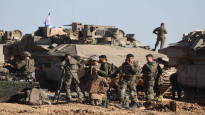Israel’s goal in Gaza is not to kill every Hamas fighter. This is simply impossible.
A more realistic goal is to eliminate Hamas’ ability to wage war. In practice, this requires the complete destruction of the terrorist organization’s above-ground buildings, weapons depots, command centers and weapons workshops.
This is the assessment of the former head of Israel’s military intelligence, General Amos Yadlin in the American magazine Foreign Affairs.
– Yep, that’s roughly what Israel’s goal is, says the program director of the American Rand think tank Raphael Cohen Yelle in a video interview.
Rand is a think tank close to the United States Defense Administration, focused on security.
Cohen, who specializes in strategy and the Middle East, says that Hamas is structurally closer to a military organization than a terrorist group. Before Israel’s October ground attack on Gaza, its strength was around 25,000-30,000 men.
It is not possible – or even necessary – to kill all these fighters stationed in different parts of the Middle East in order to break Hamas’s fighting ability.
– When talking about military units, a loss of more than 50 percent usually renders the unit inoperable, says Cohen.
Civilian casualties are hard to avoid
In Gaza, the Israeli armed forces are fighting a group of guerrillas hiding among the civilian population in a densely populated urban environment.
According to Cohen, it is difficult to imagine a more difficult battlefield.
– From a military point of view, there is no good or easy way to wage an urban war, summarizes the researcher.
Separating fighters from civilians is challenging in Gaza. Hamas fighters do not carry insignia and even minor children can pick up a gun.
At the same time, mistaking a fighter for a civilian can be a fatal mistake for a soldier serving in the Israeli forces.
According to Cohen, what weighs in Israel’s balance is the protection of its own forces and, for example, what kind of risks it is willing to accept to protect Palestinian civilians.
– How civilians are protected varies from operation to operation. The key are the rules in which situations fire is opened and, for example, what kind of weapons and ammunition are used in which situation, Cohen describes.
– Sometimes a militarily important target can be among civilians and fire is not opened. However, then you have to take the risk that this target will not be brought into the line of fire again and he will be able to escape.
In light of the casualty figures, it seems clear that the Israeli armed forces avoid putting their own troops in danger whenever possible.
So far, almost 260 Israeli soldiers have been killed in Gaza since the ground operation began. At the same time, the number of dead Palestinian children and women is counted in several thousands.
After the attack by Hamas, there was a broad consensus in the international community that Israel has the right to defend itself.
The Israeli leadership has repeatedly stressed that it has the right to capture or kill the perpetrators of the October attack and to ensure that a similar attack never happens again.
Israel also has the right to get back people kidnapped by Hamas.
According to Cohen, the key question is how these political goals can be converted into an acceptable military strategy.
– It’s already a bit more difficult, Cohen reflects.
The limits of military power
The United States’ own war experiences from both Vietnam and later Iraq prove that it is almost impossible to suppress a rebel movement supported by the civilian population with military force.
By killing one fighter, the opponent gains a martyr to recruit two more fighters.
Cohen, who served in the US armed forces in Iraq, sees this rule of thumb also applies in Gaza.
Instead of killing or imprisoning fighters, according to Cohen, it is also important to look at how well Hamas can be disarmed.
A bunch of idle, angry young men can be a dangerous element in society, but if they don’t have the weapons and command systems needed to carry out major strikes, such a threat is still a manageable problem.
– After Israel’s military operation, Hamas may still be able to fire a rocket or carry out, for example, a suicide attack requiring civilian casualties. It is no longer capable of anything like the one seen on October 7. I don’t believe that, Cohen assessed.
The leadership of Hamas is still alive
According to Cohen, the Israeli armed forces have so far been quite successful in capturing or killing Hamas’ middle management, battalion and company commanders.
However, the top management of the organization is still alive.
– My bet is that Israel wants the highest leadership of Hamas out of the game and to cut the number of infantry. When this is done, the operation will be called a success, summarizes Cohen.
After that, perhaps the most difficult phase of the Gaza operation begins – controlling the hostile territory.
The United States once quickly defeated the Iraqi armed forces, but was ill-prepared for the victory and the resulting responsibility for the occupied state.
The armed forces are good at fighting, but bad at running society.
– The big lesson of Iraq and Afghanistan has been that you have to start planning in time how to replace the old regime. Israel has not been any better here than the United States, says Cohen.
